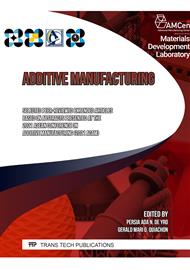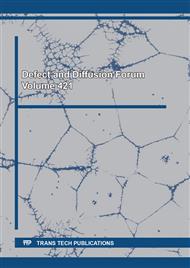[1]
B. Blakey-Milner, Metal additive manufacturing in aerospace: A review,, p.33, (2021).
Google Scholar
[2]
M. Rafiee, R. D. Farahani, and D. Therriault, Multi‐Material 3D and 4D Printing: A Survey,, Adv. Sci., 7 (2020) 1902307.
DOI: 10.1002/advs.201902307
Google Scholar
[3]
Y. Tian, R. Palad, and C. Aranas, Microstructural evolution and mechanical properties of a newly designed steel fabricated by laser powder bed fusion,, Addit. Manuf., 36 (2020) 101495.
DOI: 10.1016/j.addma.2020.101495
Google Scholar
[4]
Y. Bai, D. Wang, Y. Yang, and H. Wang, Effect of heat treatment on the microstructure and mechanical properties of maraging steel by selective laser melting,, Mater. Sci. Eng. A, 760 (2019) 105–117.
DOI: 10.1016/j.msea.2019.05.115
Google Scholar
[5]
K. Chadha, Y. Tian, P. Bocher, J.G. Spray, and C. Aranas, Jr. Microstructure Evolution, Mechanical Properties and Deformation Behavior of an Additively Manufactured Maraging Steel,, Materials, 13 (2020) 2380.
DOI: 10.3390/ma13102380
Google Scholar
[6]
R. Palad, Y. Tian, K. Chadha, S. Rodrigues, and C. Aranas Jr., Microstructural features of novel corrosion-resistant maraging steel manufactured by laser powder bed fusion, , Mater. Lett., 275 (2020) 128026.
DOI: 10.1016/j.matlet.2020.128026
Google Scholar
[7]
S.H. Kim, G.H. Shin, B.K. Kim, K.T. Kim, D.Y. Yang, C. Aranas Jr., J.P. Choi, and J.H. Yu, Thermo-mechanical improvement of Inconel 718 using ex situ boron nitride-reinforced composites processed by laser powder bed fusion,, Sci. Rep., 7 (2017) 14359.
DOI: 10.1038/s41598-017-14713-1
Google Scholar
[8]
K. Chadha, Y. Tian, J.G. Spray, and C. Aranas Jr., Effect of annealing heat treatment on the microstructural evolution and mechanical properties of hot isostatic pressed 316L stainless steel fabricated by laser powder bed fusion,, Metals, 10 (6) (2020).
DOI: 10.3390/met10060753
Google Scholar
[9]
C. V. S. Murthy, A. G. Krishna, and G. M. Reddy, Dissimilar Welding of Maraging Steel (250) and 13-8 Mo Stainless Steel by GTCAW, LBW and EBW Processes,, Trans. Indian Inst. Met., 72 (2019) 2433–2441.
DOI: 10.1007/s12666-019-01695-z
Google Scholar
[10]
T. DebRoy et al., Additive manufacturing of metallic components – Process, structure and properties,, Prog. Mater. Sci., 92 (2018) 112–224.
Google Scholar
[11]
V. K. Vasudevan, S. J. Kim, and C. M. Wayman, Precipitation reactions and strengthening behavior in 18 Wt Pct nickel maraging steels,, Metall. Trans. A, 21 (1990) 2655–2668.
DOI: 10.1007/bf02646061
Google Scholar
[12]
S. Shakerin, A. Hadadzadeh, B. S. Amirkhiz, S. Shamsdini, J. Li, and M. Mohammadi, Additive manufacturing of maraging steel-H13 bimetals using laser powder bed fusion technique,, Addit. Manuf., 29 (2019) 100797.
DOI: 10.1016/j.addma.2019.100797
Google Scholar



